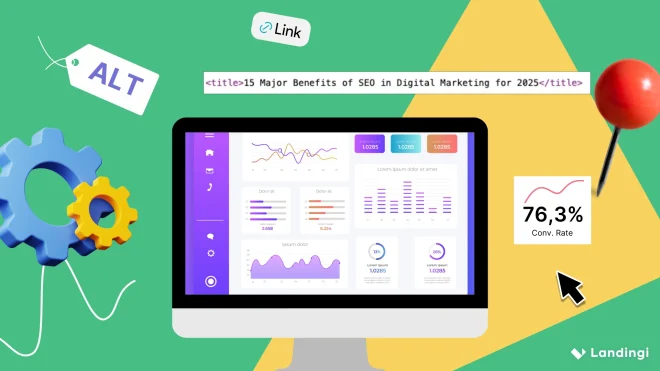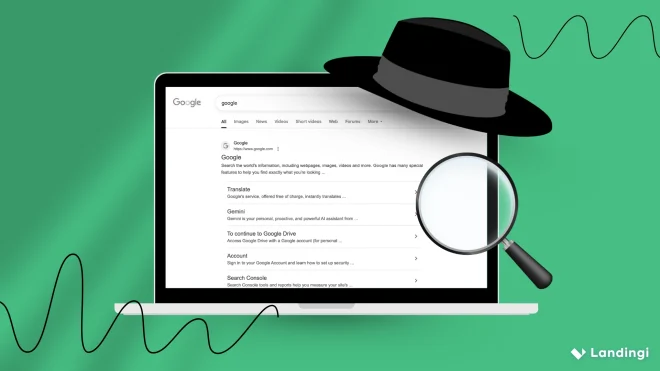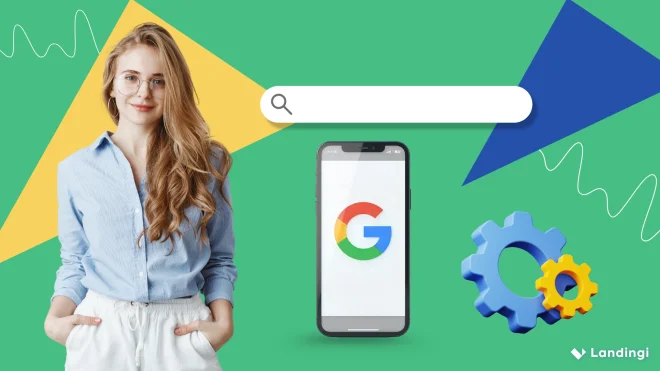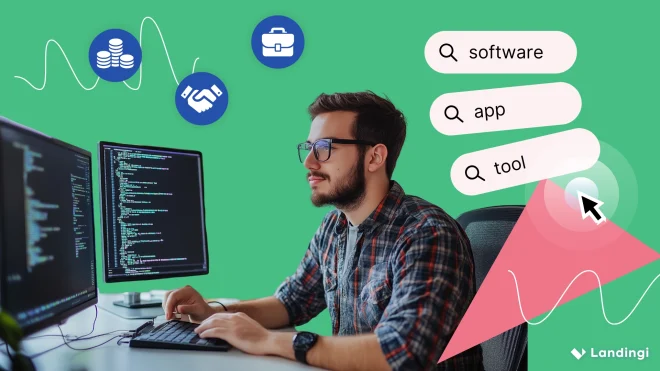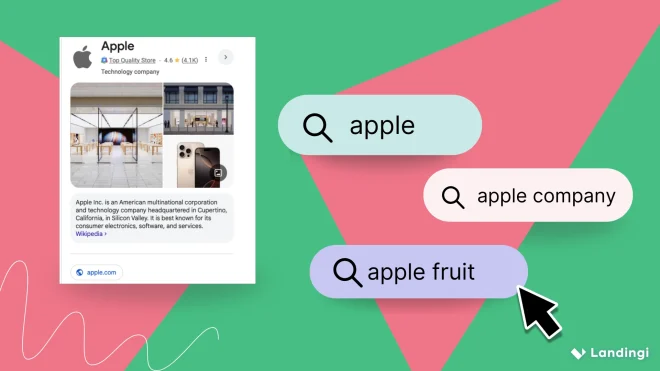Search Engine Optimization (SEO) in digital marketing is the practice of improving your website’s visibility in organic search results — so when people look for something you offer, they find you instead of your competitors. It’s one of the most powerful ways to attract qualified, high-intent traffic without relying on ads.
According to Embryo Agency, organic search drives 53% of all trackable website traffic, far more than paid or social channels. And that traffic isn’t random — it’s made up of users who are already looking for something specific. SEO helps you match their intent, deliver relevant answers, and earn trust at the exact moment it matters. It aligns your website with how search engines like Google crawl, index, and rank content. That means optimizing both technical elements (like site speed, mobile readiness, and structured data) and content signals (like keywords, headings, and internal links). When done right, search engine crawlers can easily understand your site — and reward it with better rankings.

What Is SEO (Search Engine Optimization)?
Search Engine Optimization (SEO) is the process of improving your website so that it ranks higher in search results — and shows up for the right people at the right time. It’s how you connect what you offer with what people are actively searching for.
At its core, SEO is about alignment: aligning your content, site structure, and technical setup with how people search — and how search engines like Google crawl, understand, and rank pages. When you match a user’s search intent with a fast, helpful, and well-organized page, you can earn attention, trust, and action.
This starts with keyword research — figuring out what people actually type into search engines when they’re looking for products, services, or answers. But SEO goes far beyond just adding keywords to a page. It includes everything from on page optimization (like headings, images, and internal links) to technical SEO (like site speed, crawlability, and mobile readiness) to off page SEO (like backlinks and brand signals from relevant websites).
Search engines rely on crawlers to explore the web and build massive indexes of content. Your job is to make sure your site is easy to navigate, clearly communicates what it’s about, and satisfies the user’s question better than anything else out there.
While paid ads might get you short-term clicks, SEO delivers long-term, sustainable growth. It’s what powers visibility across search engine results pages, including standard listings, featured snippets, and even Google News or product carousels.
Rank higher in search engines by designing SEO-friendly landing pages with Landingi!
What Are the Different Types of SEO and Specializations?
The 4 key types of SEO include on-page, off-page, technical, and local SEO. They cover the essentials — from what’s on your page, to how your site’s built, to how other sites talk about you.
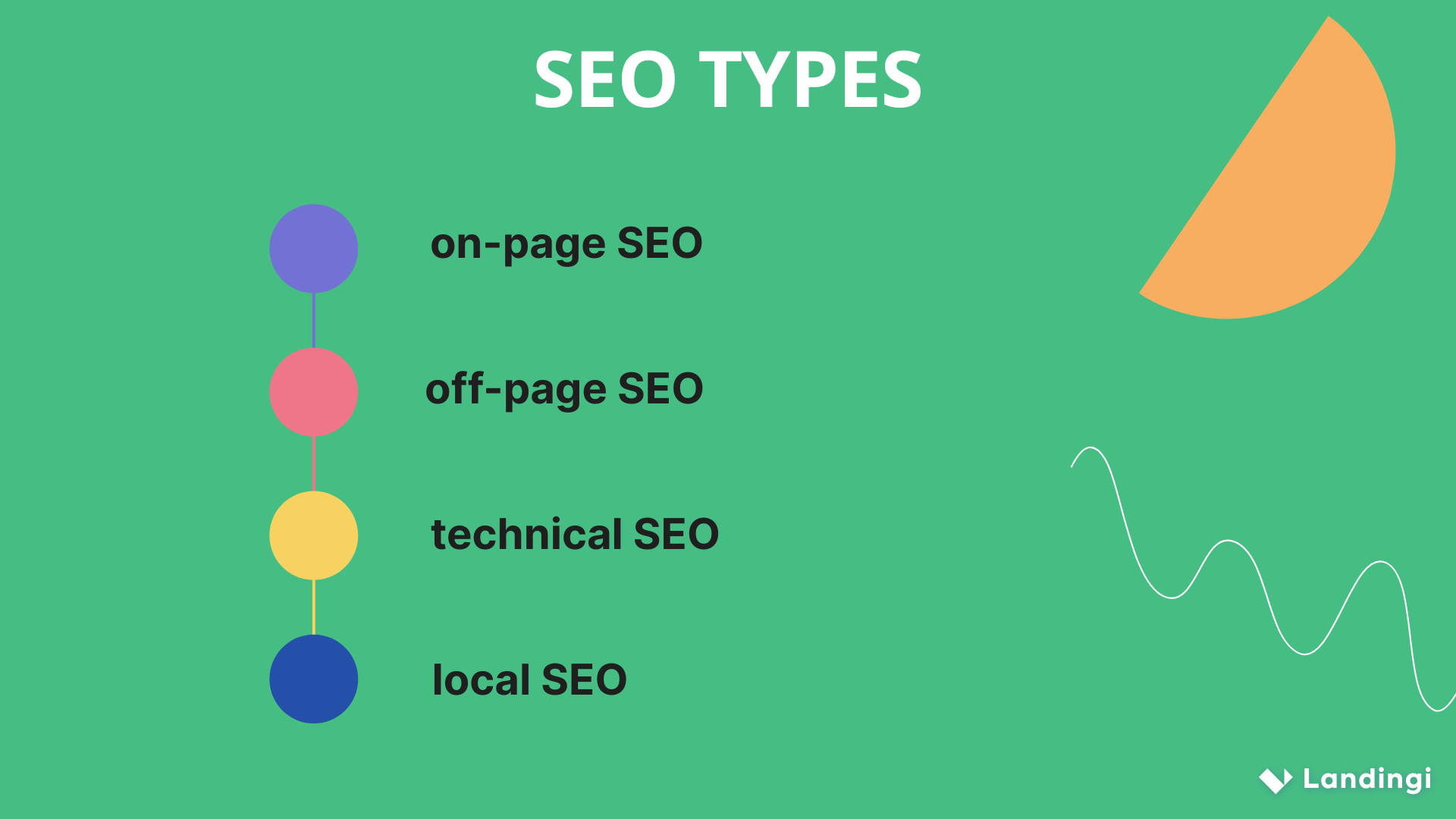
As search behavior gets more complex, so does SEO. If you’re running an online store, e-commerce SEO helps you rank product and category pages that drive real revenue. Mobile SEO ensures your site actually works (and converts) on a phone — because that’s where most traffic happens now. Video SEO boosts your visibility on YouTube and in Google’s video results, while voice SEO prepares your content for “Hey Google” and other voice-driven searches. International SEO matters when you’re targeting users across borders. Image SEO can bring in traffic through visual search. Even ASO — App Store Optimization — is part of the picture if you’ve got a mobile app.
SEO is no longer just “Google and blogs.” It’s layered, specialized, and built to match how people search in 2025 — across formats, devices, and platforms.
Here’s a breakdown of the most important types and what each one focuses on.
| Type of SEO | What It Focuses On |
|---|---|
| Content SEO | Creating optimized content aligned with user intent |
| Voice SEO | Optimizing for voice queries and natural language processing |
| E-commerce SEO | Optimizing product and category pages for search and conversions |
| Image SEO | Enhancing rankings using image alt text, titles, and compression |
| International SEO | Targeting multilingual and multi-regional audiences with SEO |
| Mobile SEO | Ensuring mobile performance, speed, and responsiveness |
| Video SEO | Getting your video content to rank in YouTube and Google video results |
| Enterprise SEO | Scaling SEO efforts for large, complex, high-traffic websites |
| App Store Optimization | Improving visibility of mobile apps in app store search results |
| White Hat SEO | Using ethical, Google-approved tactics to improve rankings |
| Grey Hat SEO | Using techniques that fall between ethical and manipulative SEO |
| Negative SEO | Using harmful SEO tactics to lower a competitor’s search ranking |
| Black Hat SEO | Manipulating rankings with tactics that violate Google’s guidelines |
What Are the Popular SEO Tools?
The popular SEO tools are: Semrush, Ahrefs, SE Ranking, Surfer SEO, Google Search Console, Screaming Frog, SpyFu, and Moz Pro. Each one helps with a different piece of the SEO puzzle — from keywords to crawl errors to competitor spying.
Semrush
All-in-one platform for SEO, content, and ads. Perfect for finding high-volume keywords, tracking rankings, and seeing what your competitors are up to.
Ahrefs
If you’re focused on link building or want to uncover your competitor’s top content — Ahrefs makes it easy.

SE Ranking
A solid, user-friendly tool for tracking keywords, running site audits, and getting SEO insights without feeling overwhelmed. Great for small teams and freelancers.
Surfer SEO
Helps you write SEO-optimized content by analyzing what already ranks. It gives real-time suggestions as you write — so your blog or landing page is built to perform.
Google Search Console (GSC)
Free, essential, and straight from Google. Shows what search queries bring traffic, which pages get seen, and where your site might need fixing.

Screaming Frog
A website crawler that spots technical SEO issues — like broken links, missing meta tags, and duplicate pages — before they tank your rankings.
SpyFu
Ideal for competitor research. See what keywords others rank for organically and what they’re paying for in ads — and find gaps you can target.
Moz Pro
A trusted classic. Moz gives keyword suggestions, page optimization scores, and rank tracking — with a friendly interface and helpful learning content.
Boost your brand with a professionally designed landing page tailored to your needs.
What Is the Market Size of SEO Services?
In 2025, the global SEO services market is valued at $106.9 billion — and it’s only growing. According to The Business Research Company, the market is expected to nearly double by 2029, reaching $194.6 billion, with a compound annual growth rate (CAGR) of 16.2%.
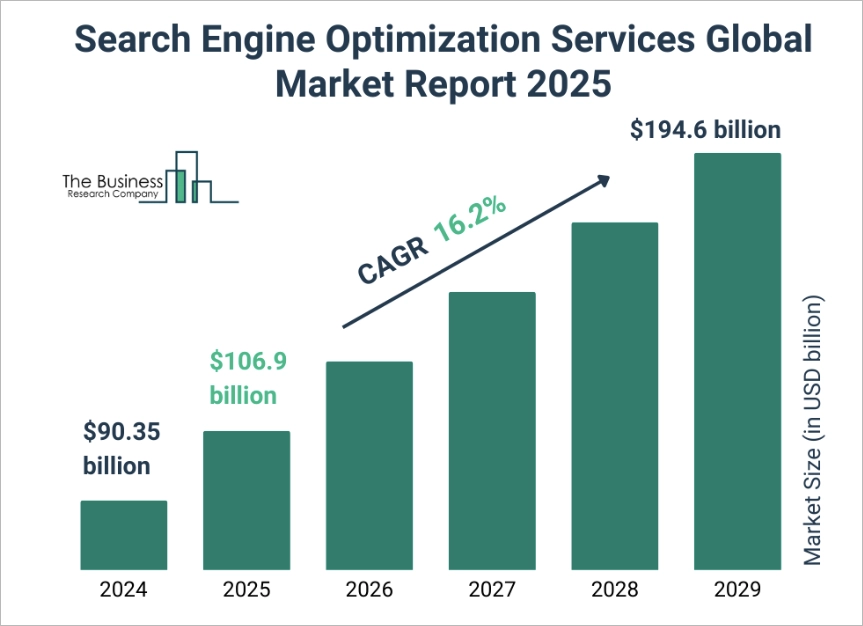
As more businesses shift online and compete for visibility, SEO is essential. Whether it’s ranking in Google’s AI Overviews, optimizing for product search, or improving site performance, companies are investing more than ever in SEO to attract high-intent traffic and stay competitive.
It means competition is heating up — and visibility won’t come by accident. With billions flowing into SEO, more brands are optimizing every page, headline, and keyword to win those top spots. If your page isn’t loading fast, matching search intent, or hitting the right high-converting keywords, someone else’s will — and they’ll take the lead, the sale, or the signup.
What Is the Role of SEO for Landing Pages?
SEO helps your landing page get seen, clicked, and acted on.
Unlike a blog post, a landing page is usually built for one thing: getting someone to take action — sign up, book a demo, start a trial. But to get that click, you first need visibility. SEO brings in people who are already searching for what you offer, using high-intent keywords like “PPC reporting software” or “best CRM for small business.”

Because landing pages are often short, focused, and standalone, they require a slightly different SEO strategy. You won’t rely on internal links or long-form content. Instead, you’ll focus on things like:
- Keyword clarity
- Fast page speed, especially on mobile
- Tight, conversion-focused copy
- Clear structure
Even if you’re running paid ads, SEO can reduce your cost per click by improving Quality Score — and when the ad budget runs out, the organic traffic keeps coming. Plus, users tend to trust pages that rank on their own more than those marked “Sponsored.”
So whether it’s a product launch, a sign-up form, or a one-page offer, SEO gives your landing page a longer shelf life — and a better chance to convert.
Build content funnels that Google understands — with templates designed to support your SEO strategy.
What Is the Role of SEO in Digital Marketing?
SEO is the backbone of digital marketing because it connects your content with the people actively searching for it. While ads push messages out, search engine optimization pulls users in — right at the moment they’re looking for solutions, products, or answers.
It supports every part of your funnel: from increasing visibility in the awareness stage to driving qualified organic traffic that converts. SEO also amplifies the impact of your content strategy, improves website optimization, and feeds valuable insights into other channels like search engine marketing and social media marketing.
In short, SEO helps you show up where it matters most — and builds long-term results that don’t disappear when the ad budget runs out.
Why Is SEO Important?
SEO is important because it increases online visibility, drives high-intent traffic, builds trust, and improves the overall user experience. It’s the engine behind how people find your business online — and how search engines decide whether to show it at all.
#1 SEO makes your site easier to find
If your website isn’t showing up in search engine results, it might as well not exist. People rarely scroll past the first page of Google search, so higher rankings mean higher visibility. The better your SEO strategy, the closer you get to that prime real estate — and that’s where the clicks are.
#2 SEO brings traffic that matters
Unlike paid ads that vanish the second you stop paying, organic traffic keeps coming when your content is optimized well. SEO helps you rank for relevant keywords that match what your audience is already looking for. As a result, people find your site when they’re already interested, not when you’re interrupting them. That kind of organic search traffic converts better and stays longer.
Pro tip: Use Google Search Console to track which search queries lead people to your site — and build content around what’s already getting results.
#3 SEO builds trust without ads
Ranking high on Google’s search results signals authority. It tells users that your content is relevant, trustworthy, and worth their time. SEO supports that trust by improving everything behind the scenes: page speed, internal links, meta tags, and even image alt text — the stuff search engine crawlers love, and users feel without noticing.
#4 SEO improves the whole experience
Good SEO = a good user experience. Search engines reward websites that make things easy for users. That means clean navigation, fast loading times, helpful content, and mobile-friendly design. In other words: SEO helps search engines understand your site — and helps users enjoy it.
Improve your SEO and attract more visitors. Build your landing page with Landingi today!
Why SEO Focuses on Google?
SEO focuses on Google because that’s where the traffic is. With over 90% of the global search engine market share, Google is the front door to the internet for most users — and if you want organic search traffic, you need to be visible where people are actually searching.
It’s not that SEO ignores other search engines. Search engine optimization, by definition, is about helping search engines discover, understand, and rank your content. But since Google handles billions of search queries daily, it’s the platform with the biggest impact on your online visibility.
Google sets the tone — and the rules. Its algorithm, built around over 200 ranking factors, is the most sophisticated in the industry. That means if your page SEO is strong enough to rank on Google, it’s probably well-optimized for other search engines too. Think of it this way: if you train to compete in the Olympics, you’ll likely win your local race too.
It also comes down to tools and data. Platforms like Google Search Console and Google Analytics give SEO professionals powerful insights into search behavior, search queries, and how search engines understand your content. These tools are built around Google’s systems — so naturally, SEO strategies lean heavily into Google’s ecosystem.
How SEO Differs from SEM and PPC?
SEO is about earning organic visibility, while SEM includes both SEO and paid methods like PPC to gain traffic from search engines. In short, SEO is a part of SEM — but not all of it.
SEO (Search Engine Optimization) is all about improving your site to rank in the organic search results — the unpaid listings you see under the ads. It involves things like writing high quality content, improving page speed, optimizing meta tags, and using relevant keywords based on search intent. The goal is simple: help search engines understand your site so that it earns its spot on the results page.
Now, SEM (Search Engine Marketing) is the broader strategy that combines both organic SEO and paid search tactics to drive traffic from search engine results pages. That includes everything from writing SEO-friendly blog posts to running Google Ads campaigns.
One layer deeper: PPC (Pay-Per-Click) is a subset of SEM that focuses purely on paid placements. Every time someone clicks your ad, you pay — hence the name. Think of those top results in Google that say “Sponsored” — that’s PPC in action. It’s fast, measurable, and great for short-term wins.
And while SEO takes time, it keeps paying off without an ad budget. PPC is faster, but once you stop spending, the traffic stops too. That’s why many brands treat search engine optimization as the foundation and layer PPC on top when needed.
Improve your SEO and attract more visitors. Build your landing page with Landingi today!
How Does SEO Work?
SEO works by helping search engines crawl, index, and rank your content — so the right people can find it at the right time. It’s about making your website understandable and valuable in the eyes of both users and algorithms.
Let’s simplify how search engines operate behind the scenes. Every time someone types a search query into Google, a complex process kicks in — but it all starts long before that moment, with three key steps: crawling, indexing, and ranking.
#1 Crawling: How search engines discover your content
Search engines use bots — also known as spiders or crawlers — to navigate the web, following internal and external links to find new pages. These crawlers land on your site, read your content, and log what they find. If your site has a clear site structure and links are well-organized, crawlers can access everything more easily.
If a new blog post is linked from your homepage, for example, a crawler landing on your homepage can follow that path and discover the new content (that’s why internal links aren’t just for navigation — they’re crucial for helping search engines understand your website as a whole).
#2 Indexing: How search engines store and assess your pages
Once your page is crawled, the next step is indexing. This is where Google’s index — a giant database of discovered content — comes in. The algorithm reviews what’s on your page and decides if it’s worth keeping.
But not every page gets in. Your content must be unique, valuable, helpful, and relevant. If it’s thin, duplicated, spammy, or impossible to access (say, due to a noindex tag or a broken link), it might be skipped altogether.
Want to check what’s already indexed? Try: site:yourdomain.com in Google search to see what’s visible — or go into the Index Coverage report in Google Search Console for more detailed insights.
#3 Ranking: How search engines decide what shows up first
After crawling and indexing, Google uses hundreds of ranking signals to decide which pages appear at the top of search engine results pages (SERPs) for each query.
Some examples of ranking factors include:
- Keywords in title tags
- Page speed
- Content quality
- Backlinks
- User experience signals
- Structured data
- Domain reputation
These factors fall under the three big buckets of technical SEO, on page SEO, and off page SEO — and your SEO efforts need to touch all three if you want consistent visibility. But don’t forget that SEO doesn’t end with Google. Platforms like YouTube, Amazon, and even social media sites use algorithms to serve content — and understanding how people search behavior works across platforms can give you an edge.
How to Start with SEO?
To start with SEO, you need to learn the basics, study what works for others, and practice on your own website. SEO isn’t something you master overnight — but you don’t need to be an expert to start seeing results. What you need is curiosity, consistency, and a plan.
Start by getting clear on what search engine optimization is. You’re not trying to trick search engines — you’re helping them understand your content, so they can show it to the right people. That means learning how search engines discover and rank web pages, and how to create content that aligns with user intent.
Here’s a beginner-friendly way to ease into it:
- Read and watch reliable resources. Start with well-known names like Moz, Ahrefs, Semrush, or Backlinko. These platforms offer practical, beginner-level guides and tutorials that explain SEO basics without jargon.
- Take a course—free or paid. Google’s Digital Garage, HubSpot Academy, and Coursera have SEO modules that cover everything from on-page SEO to technical aspects like structured data or page speed.
- Study what already works. Search for a topic in your industry and analyze the top-ranking pages. What do they have in common? Look at their titles, content structure, internal and external links, and how they answer search questions. This is competitive research in action.
- Use SEO tools. Get hands-on with free trials of tools like Ahrefs, Semrush, Screaming Frog, or Ubersuggest. Play around, click everything, compare dashboards, watch tutorials. The more familiar you are with the tools, the more confident you’ll be making SEO decisions.
- Start your own project. Create a simple website or blog and experiment. Add content around one topic, try some basic keyword optimization, and watch how it performs. Use Google Search Console to track search queries, impressions, and clicks.
- Stay current. Follow industry updates on platforms like Search Engine Journal, LinkedIn, Twitter/X (SEO Twitter is very real), or newsletters from experts. Algorithms change — and so do best practices.
Pro tip: Learn by doing. You can read 100 blog posts, but nothing will teach you faster than testing things on your own site and seeing what works (and what doesn’t).
Boost your brand with a professionally designed landing page tailored to your needs.
How SEO Evolves?
SEO is evolving fast — from keywords and links to intent, AI, and multi-platform visibility. What worked five years ago won’t cut it in 2025. Today, it’s about understanding how people search now — and showing up in the right place, with the right content, in the right format.
AI is reshaping search behavior.
People no longer rely solely on Google. They ask ChatGPT, Perplexity, Gemini. That means SEO must adapt to how AI models retrieve and summarize content, not just how search engines rank it. To stay visible, your content needs to be clear, accurate, and context-rich, so it can be quoted, referenced, or linked by AI-driven tools — not just indexed by Google.
It’s all about intent.
Google’s algorithm is smarter than ever. It doesn’t just scan for relevant keywords — it looks for high quality content that answers real questions. Pages that feel useful and complete win. Pages built just to rank get ignored.
Visibility now means everywhere.
Users start searches on YouTube, they scroll TikTok, and check Reddit threads. That’s why SEO today includes video, social content, and multimedia optimization. Your blog still matters — but it’s part of a much bigger content ecosystem.
Authority goes beyond backlinks.
Yes, backlinks still matter. But now, so do DMs, community replies, and podcast guest spots. It’s about brand reputation, expert content, and being cited — by real people, in real conversations. That includes social media sites, podcasts, and niche communities.
To sum it up, SEO in 2025 means:
- Writing for people, not just algorithms
- Being discoverable on multiple platforms
- Understanding how AI and LLMs shape search behavior
- Creating content that’s fresh, rich, and real
- Building reputation through value, not vanity metrics
How to Learn SEO?
To learn SEO, start by understanding how search engines work — then build hands-on experience by optimizing real content. Reading guides and watching tutorials will give you the theory, but you’ll learn faster by doing: test keywords, tweak meta tags, monitor changes in Google Search Console, and see what actually improves your rankings.
Follow trusted sources like Moz, Ahrefs, or Backlinko to stay updated, but don’t get stuck in learning mode — try things out, break stuff, and learn from the results. Explore SEO tools, compare data, and dig into how your competitors rank. The best SEO knowledge doesn’t come from a course — it comes from doing the work.
FAQ About SEO
Here are quick answers to the most common questions people ask about SEO.
Can I Do SEO by Myself?
Yes, you can learn and apply the basics on your own — and you absolutely should. But if you want your business to grow consistently, it’s smarter to hand it over to someone specialized in SEO. Professionals can dig deeper into technical issues, content gaps, and optimization opportunities you might miss.
What Is an Example of SEO?
Creating a landing page that ranks for “project management software” by using that keyword in the title tag, URL, headings, and copy — while making sure the page loads fast, is mobile-friendly, and clearly answers what the tool does. That’s SEO in action: aligning your content with what people search for and how search engines understand it.
Is SEO Free or Paid?
SEO itself is free — you don’t pay Google to appear in organic search results. But the tools, time, and expertise involved in doing it well often come with a cost. Whether you’re investing in SEO tools, hiring an expert, or creating high-quality content, there’s still a resource investment.
What Is SEO in Social Media?
SEO in social media means optimizing your profiles and content so they appear in search engine results or are discoverable within platforms like YouTube or LinkedIn. It’s not traditional SEO, but good keyword usage, profile links, and hashtags can boost your visibility across search platforms.
Why Is SEO So Difficult?
SEO is difficult because it’s constantly changing — algorithms evolve, competition grows, and user behavior shifts. You’re optimizing for both machines and people, across content, tech, and authority. It’s not a one-time task — it’s an ongoing process that requires both strategy and adaptability.

